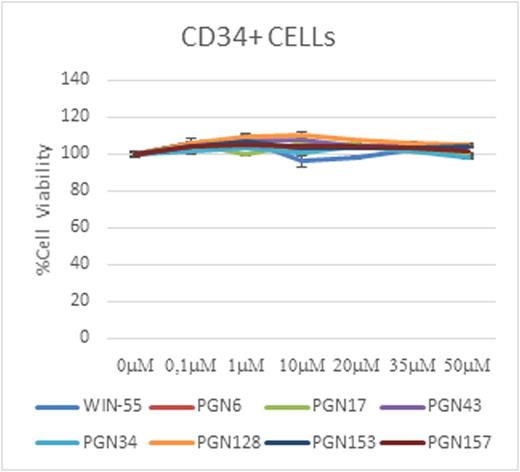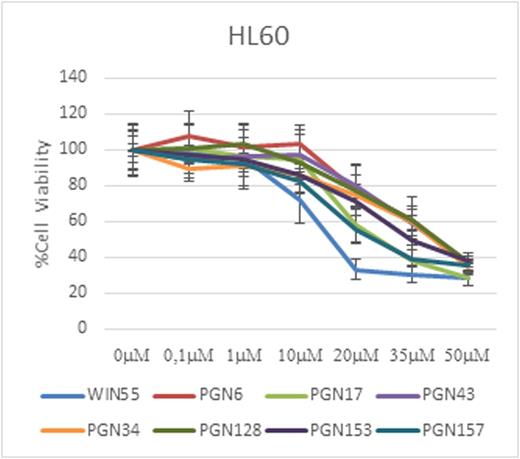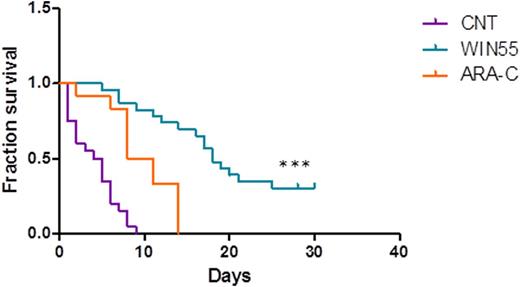Abstract
Endocannabinoid system is a set of ligands, receptors and endogenous enzymes which modulate a variety of physiological effects. There are two well-characterized cannabinoid receptors, CB1 (mainly expressed in Central Nervous System) and CB2 (mainly in hematopoietic cells).
Here, we tested the effect of the cannabinoid WIN-55 212-2 in acute myeloid leukemia (AML) in vitro, ex vivo and in vivo and studied the molecular signaling pathways involved in this effect. Moreover, we synthesized a new family of twelve cannabinoids that are specific to CB2 receptor. For their design and synthesis, computational techniques of docking, analytical and spectroscopic techniques such as mass spectrometry (MS) were used.
To assess the anti-leukemia effect of the different cannabinoids, we analyzed cell viability by MTT and flow cytometry using six human AML cell lines, primary cells from healthy donors (hematopoietic progenitor cells (HPC) and lymphocytes) and blasts from AML patients. Cannabinoids induced a potent proapoptotic effect on AML cell lines and on primary leukemic cells, which was not observed in normal HPC and lymphocytes from healthy donors.
Fragmentation of PARP and activation of caspases 2, 3, 8 and 9 were confirmed by western-blot. Other proteins involved in the effect of cannabinoids were p-AKT, p-ERK 1/2, p-38 and p- JNK. Also studies on p-PERK, p-IRE1 and CHOP confirmed an increased endoplasmic reticulum stress upon exposure to cannabinoids.
Mitochondrial damage was analyzed by flow cytometry using TMRE and by MitoSOXTMRed. These assays confirmed a very early mitochondrial damage in leukemic cells which was not observed in normal hematopoietic progenitor cells.
Moreover, we analyzed the ceramide levels, a membrane lipid associated with death/survival cell processes by HPLC and immunohistochemistry. Remarkably, we observed significant differences in the amounts of certain subtypes of ceramides in untreated versus treated leukemic cells.
The proapoptotic effect of cannabinoids on AML cells was abolished upon co-culture with either CB2 receptor antagonists or with pancaspase inhibitors.
Finally, NOD/scid/IL-2R gammae null (NSG) mice were xenotransplanted with HL60 cell line. We confirmed disease infiltration in bone marrow (BM) by BM aspirates and flow cytometry assays. Once the presence of leukemic cells was confirmed, treatment with vehicle, WIN-55 cannabinoid at a dose of 5 mg/kg/day or citarabine (ARA-C) at 50 mg/kg during 5 days was administered.
We observed a significantly increased survival among mice treated with WIN-55 cannabinoid as compared to both the control group and the group treated with ARA-C. In addition, we tested in vivo the effect of these compounds on normal hematopoiesis by treating healthy BALB-C mice. We confirmed that cannabinoids did not affect the viability of the different populations of hematopoietic progenitors (LK, GMP, CMP) and, moreover, an increased platelet count was observed in treated mice. Our findings indicate that cannabinoids display a highly selective proapoptotic effect against leukemic cells. Several pathways are involved in this effect, the modification in the ceramide pattern playing a main role.
No relevant conflicts of interest to declare.
Author notes
Asterisk with author names denotes non-ASH members.




This feature is available to Subscribers Only
Sign In or Create an Account Close Modal